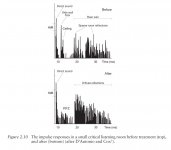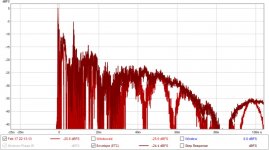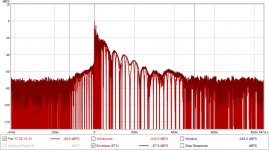POOH, I'm not sure I'm following what your goals are so far. May I ask you a question.. what are your thoughts on early reflections vs the reverberant field? I'm sure my suggestions would be dependent on such things, and your preferences toward them and what your speakers are doing there..
It's more what my room is doing to my sound. I'm looking to get better tone and articulation. I have made improvements with these diffusors but was asking if there is a program where I input my room dimensions, listening position and speaker position and it would give me an exact place to mount them for the best results.
What we have in a small room is specular reflections (besides room modes) and this needs to be treated according to the desired acoustic principle by using ETC graphs and with an understanding of broadband treatment.
Hi Omholt, can you share more details on how to treat according to ETC graph? Is it by identifying specific reflection (floor, sidewall) based on the time delay in ETC? How should those specular reflections be treated? By absorption or diffusion? Or scattering in this case?
Without looking at an RTx curve, how does one determine if there is sufficient treatment at a particular frequency band? Or if the treatment is balanced across the frequency range? Eg too much mid - high absorption and not enough bass absorption, a common beginner problem?
Sent from my X9009 using Tapatalk
Thanks, so how do we see/identify specular reflection behaviour? And once identified, do we absorb or diffuse /scatter it? How do we decide the balance of absorption vs diffusion?What Omholt is saying is, RT60 graph can't gives the specular refrection behavior. It only gives the diffused reflection. RT60 is Not useless, but not enough data for small room treatment.
Thanks!
Sent from my X9009 using Tapatalk
Correct, based on time delay. Which can be identified more accurately in several ways, but in easy way is simply to find the reflection points with a mirror, place treatment there and look at the ETC graph again.Hi Omholt, can you share more details on how to treat according to ETC graph? Is it by identifying specific reflection (floor, sidewall) based on the time delay in ETC?
Scattering is never a really good option. Whether absorption or diffusion should be used depends on desired acoustics design, and geometry and size of room. There's no quick answer here. I personally prefer attenuation early arriving reflection with either absorption or redirection and diffuse late arrival energy. The ETC will than look something like this after graph:How should those specular reflections be treated? By absorption or diffusion? Or scattering in this case?
By using broadband treatment. The knowledge of this is sufficient in avoiding alterering the spectral content. The ETC will show if there's still remaining unwanted high gain reflections. And the cumulative spectrum decay will show room resonances at low frequencies. It's also possible to use a bandlimited ETC to check closer, but it's not really necessary if the treatment one has applied is broadband. A common mistake is using too thin absorption panels and placed at surfaces that doesn't create specular reflections (random placement) at listening position, and have little or no bass trapping. Basically you never can get too much low frequency absorption.Without looking at an RTx curve, how does one determine if there is sufficient treatment at a particular frequency band? Or if the treatment is balanced across the frequency range? Eg too much mid - high absorption and not enough bass absorption, a common beginner problem?
This is a quick reply. There's much more that could be said.
Attachments
Addition to Omholts good reply; if you add broadband absorbtion it needs a certain width on the reflecting surface, not only thickness. A decorative litlle pillow isn't enough. If you figure out the "offending" frequency with REWs bandlimited ETC, make the width at least 2 wavelengths versus frequency so it covers a wider sweet spot. (At the same time frequencies a bit lower with longer wavelengths get some treatment.) If re-directing with a flat panel/angled wall towards the back wall, I would make that 2 x wavelength also.
Plasnu; I believe it does. You wish to decrease the amplitude of the reflection enough. If the new ETC (after absorbtion / re-direction) shows low enough amplitude at the same time i ms, you are "home" for that reflection. You also get an indication of how thick the absorber needs to be, if you know the offending frequency. If you have info on its air flow resistivity, you can enter this in a spread sheet / calculator and calculate backwards for required thickness. Often the manufacurer has absortion coefficients for various thicknesses too. (OK, these are usually measured from many angles in a reverberant chamber and not from one specific oblique angle, but you get an indication at least.)
- Status
- This old topic is closed. If you want to reopen this topic, contact a moderator using the "Report Post" button.
- Home
- Loudspeakers
- Multi-Way
- Placement of Diffusors


